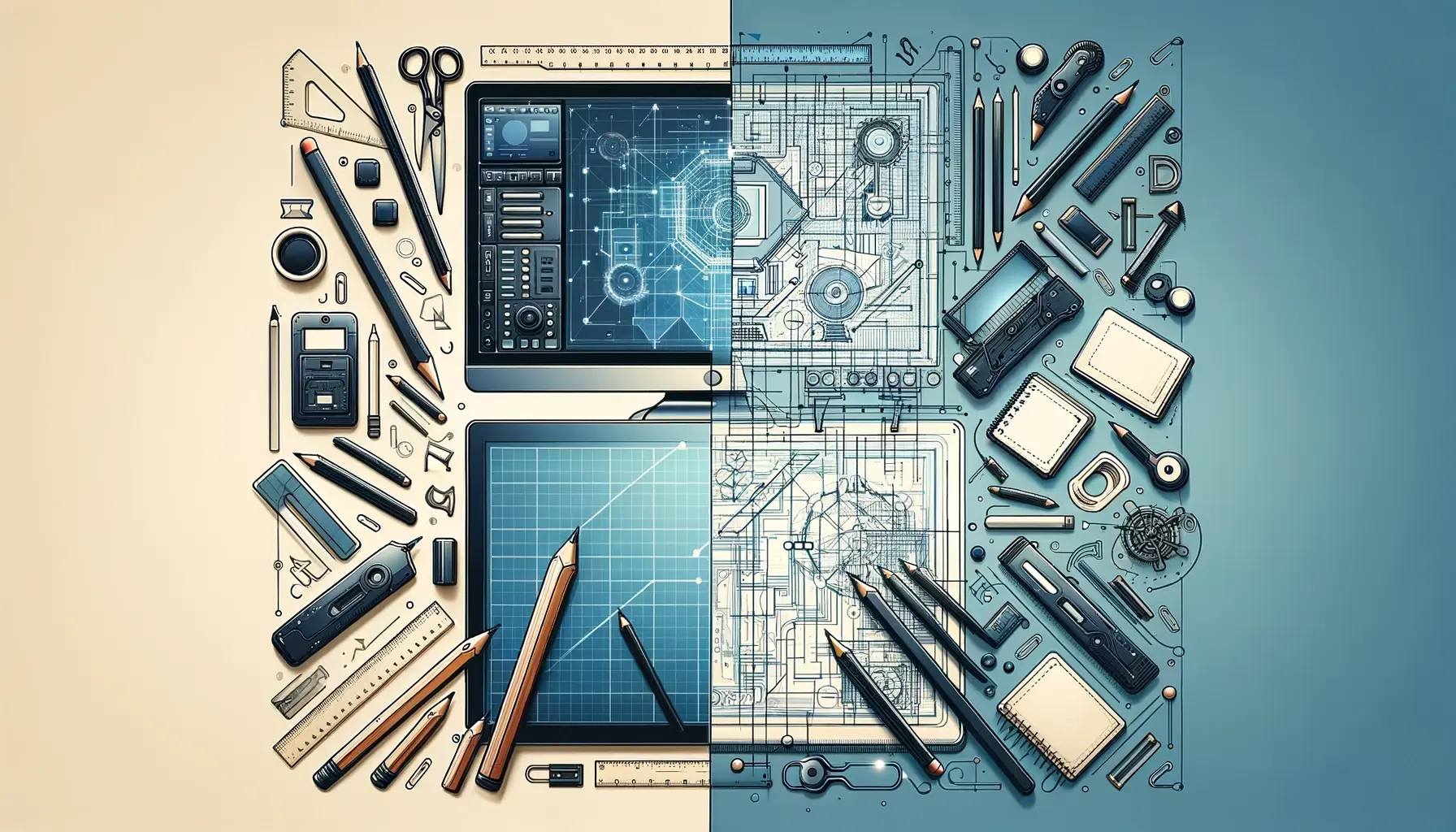As the old saying goes, ‘necessity is the mother of invention.’
You’ve used traditional design methods for years, but now there’s a new kid on the block – AI design tools. They’re shaking up the industry, but are they better?
Let’s dive deep into the pros and cons of each, comparing their capabilities and drawbacks. By the end, you’ll know if you’re ready to embrace the innovation or stick with the tried-and-true.
Understanding Traditional Design Methods
Before we delve into AI design tools, let’s first understand the basics of traditional design methods that have been around for several decades. These methods, often manual in nature, have shaped the design process for years, setting benchmarks for quality and consistency.
Understanding traditional design methods is akin to studying the roots of a tree. These methods are rooted in manual techniques such as sketching, drafting, and physical prototyping. These techniques require a high level of skill, precision, and creativity from the designer. Moreover, they allow for a tangible, hands-on approach to design, providing a level of detail and personal touch that digital methods mightn’t fully replicate.
However, the traditional design process can be time-consuming and labor-intensive. It may also be prone to inconsistencies and errors, especially when translating designs from one format to another. Despite these challenges, traditional design methods have proven their worth over time, fostering creativity, precision, and a strong foundation for designers.
Pros of Traditional Design
Diving into the advantages of traditional design, you’ll appreciate its ability to foster creativity and precision, despite being more labor-intensive and time-consuming. Traditional methods allow you to make design decisions that are unique, tailored, and bespoke. This human touch is something that machines, even the most sophisticated AI, can’t replicate.
Now, consider traditional methods in the context of interior design or industrial design. With these methods, you have the capacity to make every project unique, as designers bring their personal touch, intuition, and experience to the table. This is particularly valuable when you’re dealing with complex design problems or working on projects with specific cultural or historical contexts.
Also, traditional design methods often involve more interaction with materials, physical models, and prototypes. This tactile approach can provide a deeper understanding of the project and lead to more innovative solutions. You’ll also find that this approach can lead to a better appreciation of the craftsmanship involved in design.
Cons of Traditional Design
Despite the benefits, you might find traditional design methods falling short in certain areas. One of the main cons of traditional design is the inability to meet tight deadlines. These methods often require more time because they’re manual processes that can’t be sped up by automation.
Another downside is that these methods can struggle with complex tasks. While traditional design methods often excel at simple, repetitive tasks, they may fall short when it comes to intricate, multi-faceted projects. If you’re dealing with a complex design problem, it’s possible that traditional methods won’t be able to deliver the same level of precision or creativity as AI design tools.
Furthermore, traditional design requires human interaction. While this can be a pro in some contexts, it can become a con when you’re dealing with large scale projects or remote work scenarios. The need for constant communication and collaboration can slow down the design process and lead to inconsistencies.
Deep Dive Into AI Design Tools
Now, let’s turn our attention to a significant number of AI design tools, which you’ll find can effectively address some of the challenges posed by traditional design methods. These tools leverage advanced technology, like machine learning, to automate and enhance design processes.
- Taking a deep dive into AI design tools, you’ll discover that they can generate designs, prototypes, and more, with minimal human intervention. These AI-generated outputs are often as good as, or even better than, those produced by conventional methods. They’re not only efficient but also innovative, pushing design boundaries in ways humans can’t.
Moreover, AI design tools offer the advantage of speed. They can accomplish tasks in a fraction of the time it would take using traditional design methods. This speed and efficiency can be a game-changer, particularly in industries where time is of the essence.
However, like anything, these tools have their pros and cons. On the downside, they might lack the human touch and creativity. They could also be challenging to manage for those not tech-savvy. Despite these potential drawbacks, the benefits of AI design tools often outweigh the negatives, making them a promising alternative to traditional design methods.
Advantages of AI Design Tools
With the use of AI design tools, you’re not only gaining efficiency but also stepping into a realm of limitless creative potential. These AI-powered applications have redefined the boundaries of design, offering an array of advantages over traditional design methods.
One significant advantage of AI design tools is their ability to learn and adapt. They can analyze your design patterns, improving their suggestions based on your style and preferences. This personalized approach ensures a smooth workflow, enhancing productivity while reducing design time.
Another benefit lies in their predictive capabilities. AI design tools can provide suggestions before you even ask for them. They can anticipate your needs, offering you solutions before you even realize you need them.
Moreover, AI design tools allow for advanced data analysis, generating insights that can influence design decisions. They’re capable of sifting through vast amounts of data, identifying trends and patterns that can inform and inspire your designs.
However, like any technology, AI design tools come with their pros and cons. It’s essential to weigh these before fully transitioning from traditional design methods. Despite any drawbacks, the advantages of AI design tools present a compelling case for their adoption. So, are you ready to embrace the AI revolution in design?
Drawbacks of AI Design Tools
However, it’s crucial that you’re aware of the potential drawbacks that come with AI design tools as well. While they provide a range of benefits, there are certain cons that can’t be overlooked.
One of the key drawbacks of AI design tools is their high cost. Compared to traditional design methods, AI tools are far more expensive to purchase and maintain. This can make them inaccessible for smaller businesses or solo designers.
Moreover, AI design tools aren’t fully autonomous. They still require human intervention for tasks such as setting up parameters, interpreting results, and making final design decisions. This means that they may not always save as much time or effort as expected.
Data privacy is another concern. AI tools often require access to large amounts of data, which can raise security issues. Without proper safeguards, sensitive information could be at risk.
Lastly, AI vs traditional design is a debate that often overlooks the creative aspect of design. AI tools can analyze and optimize, but they lack the human touch and creativity that traditional design methods offer.
Balanced Comparison: AI Vs Traditional
In choosing between AI and traditional design methods, you’ve got a significant decision to make, each offering distinct pros and cons.
AI design tools are revolutionizing the design world with their speed, accuracy, and ability to handle large volumes of data. They can streamline the design process, automate routine tasks, and offer innovative solutions.
Conversely, traditional design methods provide a human touch, allowing for personal creativity and intuition. You can make adjustments based on your experience and instincts, something that AI can’t replicate. However, traditional methods can be time-consuming and less precise, especially when dealing with complex designs or large amounts of data.
In a balanced comparison, it’s clear that both AI and traditional methods have their place. AI offers efficiency and innovation, whereas traditional methods offer creativity and personal touch. Your choice between AI vs traditional design methods will depend on your specific needs and the nature of your project. Consider the pros and cons carefully, and you’ll find the method that best suits your design process.
Both methods can complement each other in the right circumstances, creating a synergy that leverages the strengths of each.
Conclusion
In the end, it’s all about balance. Traditional design methods have their charm, but you can’t ignore the efficiency of AI design tools. They’re not perfect, but their potential is undeniable.
The trick is to blend the old with the new, the human touch with the machine’s precision. As a designer, your creativity is your greatest tool, whether you’re sketching by hand or utilizing AI.
So, go on, embrace the future, but don’t forget your roots.


